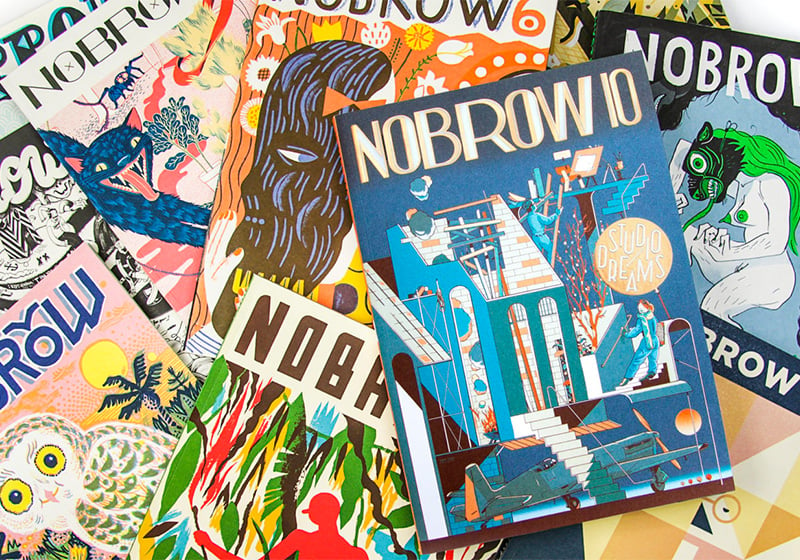Table of Contents
The story behind the influential illustrated magazine founded by two young British creatives
In the vast landscape of independent magazines, there are some titles that stand out for their style and quality, becoming international trendsetters in the process.
One of the most popular magazine genres of recent years is the art magazine, particularly those focused on illustration and folk art. Of the myriad titles that have sprung up over the last decade, one of the earliest and most interesting is Nobrow.

PREMIUM COMICS
Nobrow was founded in London in 2008 by two friends, Sam Arthur and Alex Spiro, alumni of the prestigious Central St. Martins art school.
The first issue of the magazine, Nobrow 1: Gods and Monsters, was published a year later.
The idea was to bring premium publications to a space where hitherto little attention had been paid to print and graphic design quality. There were mainstream titles and then there were niche publications that used the lo-fi, DIY approach of fanzines.
Nobrow started a trend that continues to this day: the publishing of independent comics and graphic novels that pay as much attention to storytelling as they do graphic design, individual images and presentation of the end product. Its compact 17×23 cm format and thick paper gives the magazine a book-like appearance, which also means that it’s perceived as being a more premium product than a soft-cover album with thin pages (and it does indeed cost more to print!)

Copies of Nobrow’s first issue can now fetch hundreds of pounds online, which gives you an idea of just how highly the magazine is regarded by the visual culture community.
LITHOGRAPHY AND IMAGINATION
One of the signature features of Nobrow is the use of lithographic printing, which gives the magazine’s colourful, illustration-laden pages that vintage and “old school” look so beloved of readers. What’s more, from the outset Nobrow has favoured a folk-art style that was not nearly as fashionable 15 years ago as it is today. In doing so, it has played an instrumental role in popularising this simple, colourful and image-heavy aesthetic around the world.

One of the great strengths of Nobrow is that it has always blurred the boundaries between comic, graphic novel and picture book, thereby encouraging cross-pollination and creative collaboration between artists.

Another of the magazine’s unusual characteristics is its double cover (i.e. it doesn’t have a traditional back cover), which emphasises its many dualities: comic/illustrated book, story/single image, sequence/fragment.
SUCCESS
As was often the case for magazines born in the early 2000s, many early contributors were commissioned after contacting the magazine themselves, rather than being actively sought out by the founders. After all, a commission for a magazine of this kind was highly coveted by artists, authors, cartoonists and illustrators with original styles that were not necessarily favoured by traditional mass-market publishers.

Over the years, as well as putting out the magazine, founders Arthur and Spiro have gradually built a publishing business that now takes up most of their time (just 10 issues of Nobrow magazine have been published at a rate of roughly one a year): Nobrow and Flying Eye Books, its children’s book imprint, have now published almost 200 titles.

Flying Eye Books specialises in illustrated children’s books and has found worldwide success, in part by drawing on the pool of talent whose work it has published in the magazine over the years.
AN UNMISTAKEABLE STYLE
Nobrow has developed a bold and unmistakeable style. As often happens to trendsetters, many other publishers have attempted to copy Nobrow’s visual style, but few have managed to pull it off with the same care and consistency.

Nobrow shows us how an idea that is strong, original and born of genuine passion can lead to commercial success, even in a niche sector like comics and children’s books.

